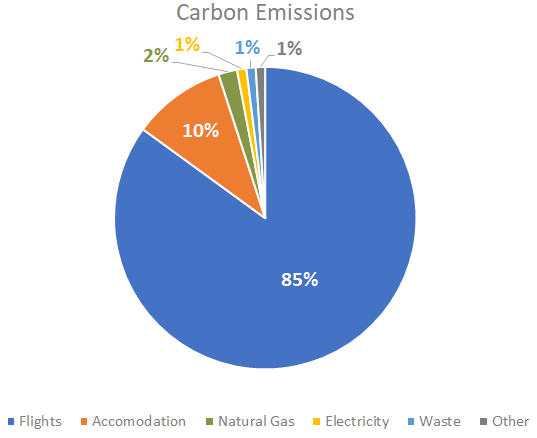Taking responsibility for our emissions and investing in the green economy
As summer winds down to an end we find ourselves at the start of conference season. Have you ever considered the impact of one of these events? Or just how much carbon is emitted as a result of running the venue(s), transportation requirements, and especially the travel needed for delegates? The results may surprise you.
A single event with 250 international delegates can have a carbon footprint comparable to 1,300 barrels of oil (412 tCO2e)
The vast majority of these emissions result from delegate flights. This is generally followed by delegate accommodations, then the needs of the venue(s).

Why does all this matter? Because climate change is a serious issue that affects us all. So what can we do about it? Organize your events to be carbon neutral!
Reducing Emissions
The first step in the journey to carbon neutrality is reducing emissions as much as possible. From day 1 of the planning stages this goal needs to be kept in mind as “status-quo” thinking will not lead you to maximizing your potential. Plan your venue(s) around the idea of minimizing your impact: use natural daylight when possible and turn off lights/ electronics when not in use; develop a procurement policy focused on minimizing emissions and environmental impacts; book your accommodations within walking distance of the venue(s) to minimize transportation requirements; minimize waste and maximize diversion rates; and aim to book air travel as direct flights whenever possible.
Going Carbon Neutral
No mater how hard we try, unfortunately, it is impossible to reduce our carbon emissions to zero. This is where offsets come in: they provide a practical and affordable way to do something about those emissions that do remain.
There is a large variety of carbon offsets on the market including renewable energy generation (solar, wind), reforestation projects, habitat restoration, and waste to energy projects. What you choose to support is up to you and your organizing committee, just be sure to go through an accredited provider such as Offsetters.

Image source: http://marketplace.carbonmarketinstitute.org/participate/
Benefits
The obvious benefit of going carbon neutral is having a direct impact on reducing emissions and contributing to a more sustainable future. But many other advantages also exist including:
- Build brand love: recognition and positive PR
- Show yourself as a climate leader
- Reduce visual wastes
- Team pride and attracting new volunteers
- Engage new sponsors
- Directly help to develop solutions for reducing emissions long-term through the purchase of offsets
- Increase customer recognition
- A new competitive edge
- Enhance corporate responsibility
- Networking opportunities with other certified entities
Funding Your Project
Let’s be honest, event budgets aren’t yet created with carbon neutrality in mind. Thankfully, there are a couple easy to implement strategies to help raise those funds:
– Introduce a new sponsorship category. With this, sponsors can choose to donate directly to purchasing offsets.
– Introduce a “climate/ eco-fee” in registration packages. Keep the fee high enough to help you out, but low enough that registrants won’t bat an eye an the additional cost. This is also a great way to ensure each and every one of your participants are contributing to creating a carbon neutral event; instilling the “all hands on deck” approach needed to combat climate change.
